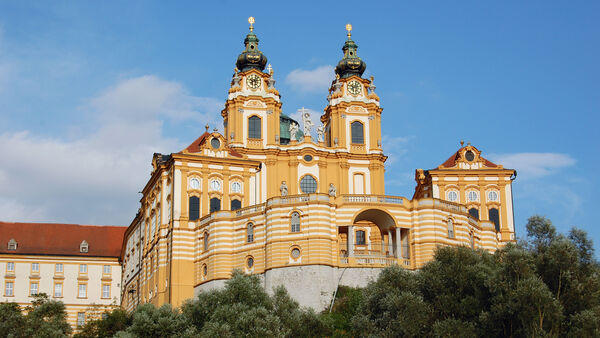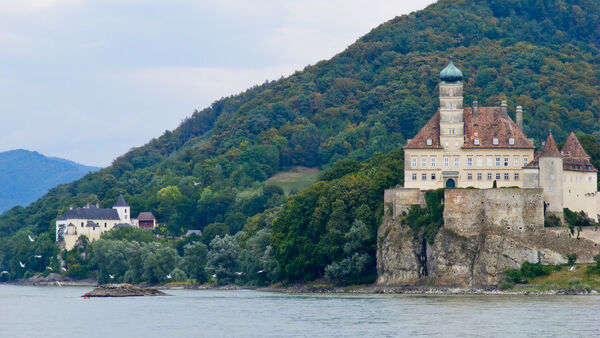A Day Out in the Danube’s Wachau Valley



By Rick Steves
The Wachau Valley, where the Danube River makes its way toward Vienna, is blanketed with vineyards and ornamented with cute villages. And the 24-mile stretch of the Wachau between the towns of Melk and Krems is as pretty as river valleys come.
For a fine day trip from Vienna, catch the early train to Melk, tour its glorious abbey, eat lunch, and spend the afternoon meandering down the river to Krems by bike, bus, or boat. From Krems, catch the train back to Vienna.
Melk is sleepy and elegant under its huge abbey. The restored Melk Abbey (Benediktinerstift), beaming proudly over the Danube Valley, is one of Europe's great sights. Established as a fortified Benedictine abbey in the 11th century, it was destroyed by fire. What visitors see today is 18th-century Baroque.
The grand restoration project — financed in part by the sale of the abbey's Gutenberg Bible to Harvard (which was later donated to Yale University) — was completed by 1996 to celebrate the 1,000th anniversary of the first reference to a country named Österreich (Austria).
For 900 years, monks of St. Benedict have lived and worked in Melk's abbey, during the Reformation (1500s), occupation by Napoleon (1800s), and the Nazis (1900s). Today, the institution survives, funded by agriculture and your visit.
High above the grand entry are the Latin words "Glory only in the cross" and a huge copy of the Melk Cross (one of the abbey's greatest treasures — the original is hiding in the treasury, viewable only with special permission). Inside is the art-lined Imperial corridor, abbey museum, "Marble Hall" (made mostly of stucco) with an impressive 1731 ceiling fresco by Tirolean Paul Troger; library (with another Troger fresco), and the grand finale: the full-on Baroque church with its 200-foot-tall dome and symmetrical towers.
Just outside is the abbey's park, with its picturesque Baroque pavilion housing some fine Bergl frescoes and a café.
Consider making your way down the river by bike. The three- to four-hour, gently downhill pedal from Melk to Krems takes you through the most scenic stretch of the Wachau Valley. Cyclists rule here, and you'll find all the amenities that make this valley so popular with Austrians on two wheels. (Ask Melk's tourist information office for the latest on bike-rental options.)
You can bike either the south or the north side of the river. The advantage of the south side is that there’s a dedicated, paved bike path the whole way; at worst you ride next to — but never on — the road (which has less traffic than the north side). The south side is much quieter and more rural, but there are still plenty of vineyards and small Gasthöfe in the villages along the way. The north side has more attractions, but also heavier traffic and arguably poorer views. Inexpensive ferries carry people, bikes, and cars regularly across the river at three points (Spitz, Weissenkirchen, and Dürnstein), so you can also change sides midstream.
You can also just hop a boat along this route. From May through September, five boats a day make the 1.75-hour trip. (Because of the six-knot flow of the Danube, the same ride back upstream takes three hours.)
Just downstream of Melk lies the town of Willendorf, known among prehistorians as the town where the oldest piece of European art was found. The village's two-room, smartly designed museum, the Venusium, tells the story of the Venus of Willendorf, the well-endowed, 30,000-year-old fertility symbol found here. Above the museum you can visit the point where the statue was actually discovered during railway construction in 1908, and you can see where the hillside has been cut away to reveal the layers of sediment deposited over the millennia.
Farther along is Dürnstein, a touristic flypaper of a town with traffic-free quaintness and its one claim to fame (and fortune): Richard the Lionhearted was imprisoned here in 1193. Despite the hordes of tour-bus and cruise-ship visitors, the town is a delight — almost like a Disney movie (but with stores selling overpriced ice cream and apricot jam). The ruined castle above town, where Richard was kept, can be reached by a fairly steep 30-minute hike with great river views.
Finally, you reach Krems, a true gem, with a shopper's-wonderland old town. If you decide you want to stay, the tourist office can help you find a room in a private home. Otherwise, Vienna's just a one-hour train ride away.

